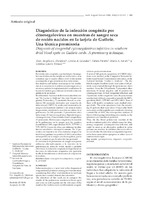Please use this identifier to cite or link to this item:
http://sgc.anlis.gob.ar/handle/123456789/165| Title: | Diagnóstico de la infección congénita por citomegalovirus en muestras de sangre seca de recién nacidos en la tarjeta de Guthrie. Una técnica promisoria | Other Titles: | Diagnosis of congenital cytomegalovirus infection in newborn dried blood spots on Guthrie cards. A promissory technique | Authors: | Distéfano, Angélica González, Cecilia A. Pardón, Fabián Sarubi, María A. Cañero Velasco, María C. |
Keywords: | Citomegalovirus;Diagnóstico;Infección | Issue Date: | 2008 | Description: | En la infección congénita y perinatal por citomegalovirus el laboratorio cumple un rol decisivo, si se considera que el cuadro clínico en el recién nacido es semejante al que presentan otras infecciones. Los objetivos del trabajo son comparar los resultados de la reacción de la polimerasa en sangre seca y en orina y señalar la importancia del resultado en la tarjeta de Guthrie, para diferenciar la infección congénita de la perinatal. En el Instituto Nacional de Enfermedades Infecciosas "Dr. Carlos G. Malbrán", Servicio Virosis Congénitas Perinatales y Transmisión Sexual, se estudiaron 148 pacientes derivados por sospecha de infección por CMVH. Se analizaron las muestras de sangre seca (tarjeta de Guthrie) y de orina de todos los pacientes, mediante la reacción en cadena de la polimerasa. De 148 pacientes, 3 presentaron otras infecciones, 95 fueron negativos y 50 positivos para citomegalovirus: 35 fueron infecciones congénitas y 15 perinatales. En los casos congénitos, la reacción de la polimerasa en la sangre seca fue positiva (sensibilidad 100%, especificidad 98,9%, VPP 98% y VPN 100%). Cuatro de ellos, con síntomas tardíos, fueron estudiados retrospectivamente. En 15 pacientes con muestras de orina tomadas después de los 15 días y polimerasa positiva (S 100%), el análisis retrospectivo de la sangre seca fue negativo, por lo que se consideró que la infección fue perinatal. La reacción de la polimerasa en sangre seca puede utilizarse alternativamente a la reacción de la polimerasa en orina de recién nacido y permite diferenciar la infección congénita de la perinatal en los casos de infecciones congénitas con aparición tardía de los síntomas u otros casos de origen controvertido. Laboratories play a crucial role in the diagnosis of congenital and perinatal cytomegalovirus infection, considering that other viral infections in newborn infants have similar clinical characteristics. The objectives of this work are to compare the results of the polymerase reaction in blood spots and urine as well as point out the relevance of the result in the Guthrie cards to differentiate congeni- tal from perinatal infection. A total of 148 patients suspicious of CMVH infections were studied in the Congenital Perinatal Infections and Sexual Transmission Laboratory, at the National Institute "Carlos G. Malbrán". The dry blood samples (Guthrie cards) and urine of all patients were studied through the polymerase chain reaction. From the 148 patients, 3 presented other infections, 95 tested negative and 50 positive for cytomegalovirus: 35 had congenital infection and 15 perinatal. In the congenital cases, the polymerase reaction in dry blood was positive (sensitivity 100%, specificity 98.9%, VPP 98% and VPN 100%). Four of them with tardive symptoms were studied retrospectively. The urine specimens from the remaining 15 patients that were taken 15 days after birth were analyzed through the same methods, showing a sensitivity of 100%, the retrospective analysis of this dry blood group yielded negative results, so the infection was considered perinatal. Thus, the dry blood polymerase reaction of the newborn infants makes it a reliable assay for diagnosing congenital cytomegalovirus infection and could be used as an alternative method to urine polymerase reaction. In addition, this test is able to reveal whether the infection is congenital or perinatal in those cases of late symptom or other cases of controversial origin. Fil: Distéfano, Angélica. ANLIS Dr.C.G.Malbrán. Instituto Nacional de Enfermedades Infecciosas; Argentina. Fil: González, Cecilia A. ANLIS Dr.C.G.Malbrán. Instituto Nacional de Enfermedades Infecciosas; Argentina. Fil: Pardón, Fabián. ANLIS Dr.C.G.Malbrán. Instituto Nacional de Enfermedades Infecciosas; Argentina. Fil: Sarubi, María A. Hospital Materno Infantil Ramón Sardá; Argentina. Fil: Cañero Velasco, María C. Hospital del Niño de San Justo. Servicio de Gastroenterología y Hepatología; Argentina. |
URI: | http://sgc.anlis.gob.ar/handle/123456789/165 http://www.scielo.org.ar/pdf/aap/v106n2/v106n2a07.pdf |
ISSN: | 1668-3501 | Rights: | info:eu-repo/semantics/openAccess |
| Appears in Collections: | snrd Publicaciones INEI |
Files in This Item:
| File | Description | Size | Format | |
|---|---|---|---|---|
| ArchivosArgentinosdePediatría,2008,106(2),132–137.pdf | 79.39 kB | Adobe PDF |  View/Open |
Page view(s)
203
checked on Jan 5, 2026
Download(s)
58
checked on Jan 5, 2026
Google ScholarTM
Check
Items in DSpace are protected by copyright, with all rights reserved, unless otherwise indicated.

